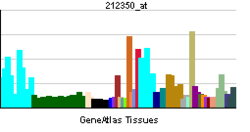TBC1D1
| TBC1 (tre-2/USP6, BUB2, cdc16) domain family, member 1 | |||||||||||||
|---|---|---|---|---|---|---|---|---|---|---|---|---|---|
| |||||||||||||
| Identifiers | |||||||||||||
| Symbols | TBC1D1 ; TBC; TBC1 | ||||||||||||
| External IDs | OMIM: 609850 MGI: 1889508 HomoloGene: 56856 GeneCards: TBC1D1 Gene | ||||||||||||
| |||||||||||||
| RNA expression pattern | |||||||||||||
 | |||||||||||||
| More reference expression data | |||||||||||||
| Orthologs | |||||||||||||
| Species | Human | Mouse | |||||||||||
| Entrez | 23216 | 57915 | |||||||||||
| Ensembl | ENSG00000065882 | ENSMUSG00000029174 | |||||||||||
| UniProt | Q86TI0 | Q60949 | |||||||||||
| RefSeq (mRNA) | NM_001253912 | NM_001289514 | |||||||||||
| RefSeq (protein) | NP_001240841 | NP_001276443 | |||||||||||
| Location (UCSC) | Chr 4: 37.89 – 38.14 Mb | Chr 5: 64.16 – 64.35 Mb | |||||||||||
| PubMed search | |||||||||||||
TBC1 domain family member 1 is a protein that in humans is encoded by the TBC1D1 gene.[1][2]
TBC1D1 is the founding member of a family of proteins sharing a 180- to 200-amino acid TBC domain presumed to have a role in regulating cell growth and differentiation. These proteins share significant homology with TRE2 (USP6; MIM 604334), yeast Bub2, and CDC16 (MIM 603461) (White et al., 2000).[supplied by OMIM][2]
References
- ↑ White RA, Pasztor LM, Richardson PM, Zon LI (Sep 2000). "The gene encoding TBC1D1 with homology to the tre-2/USP6 oncogene, BUB2, and cdc16 maps to mouse chromosome 5 and human chromosome 4". Cytogenet Cell Genet 89 (3-4): 272–5. doi:10.1159/000015632. PMID 10965142.
- ↑ 2.0 2.1 "Entrez Gene: TBC1D1 TBC1 (tre-2/USP6, BUB2, cdc16) domain family, member 1".
Further reading
- Nakajima D, Okazaki N, Yamakawa H et al. (2003). "Construction of expression-ready cDNA clones for KIAA genes: manual curation of 330 KIAA cDNA clones.". DNA Res. 9 (3): 99–106. doi:10.1093/dnares/9.3.99. PMID 12168954.
- Roach WG, Chavez JA, Mîinea CP, Lienhard GE (2007). "Substrate specificity and effect on GLUT4 translocation of the Rab GTPase-activating protein Tbc1d1.". Biochem. J. 403 (2): 353–8. doi:10.1042/BJ20061798. PMC 1874243. PMID 17274760.
- Stone S, Abkevich V, Russell DL et al. (2006). "TBC1D1 is a candidate for a severe obesity gene and evidence for a gene/gene interaction in obesity predisposition.". Hum. Mol. Genet. 15 (18): 2709–20. doi:10.1093/hmg/ddl204. PMID 16893906.
- Otsuki T, Ota T, Nishikawa T et al. (2007). "Signal sequence and keyword trap in silico for selection of full-length human cDNAs encoding secretion or membrane proteins from oligo-capped cDNA libraries.". DNA Res. 12 (2): 117–26. doi:10.1093/dnares/12.2.117. PMID 16303743.
- Rush J, Moritz A, Lee KA et al. (2005). "Immunoaffinity profiling of tyrosine phosphorylation in cancer cells.". Nat. Biotechnol. 23 (1): 94–101. doi:10.1038/nbt1046. PMID 15592455.
- Gerhard DS, Wagner L, Feingold EA et al. (2004). "The status, quality, and expansion of the NIH full-length cDNA project: the Mammalian Gene Collection (MGC).". Genome Res. 14 (10B): 2121–7. doi:10.1101/gr.2596504. PMC 528928. PMID 15489334.
- Jin J, Smith FD, Stark C et al. (2004). "Proteomic, functional, and domain-based analysis of in vivo 14-3-3 binding proteins involved in cytoskeletal regulation and cellular organization.". Curr. Biol. 14 (16): 1436–50. doi:10.1016/j.cub.2004.07.051. PMID 15324660.
- Colland F, Jacq X, Trouplin V et al. (2004). "Functional proteomics mapping of a human signaling pathway.". Genome Res. 14 (7): 1324–32. doi:10.1101/gr.2334104. PMC 442148. PMID 15231748.
- Ota T, Suzuki Y, Nishikawa T et al. (2004). "Complete sequencing and characterization of 21,243 full-length human cDNAs.". Nat. Genet. 36 (1): 40–5. doi:10.1038/ng1285. PMID 14702039.
- Strausberg RL, Feingold EA, Grouse LH et al. (2003). "Generation and initial analysis of more than 15,000 full-length human and mouse cDNA sequences.". Proc. Natl. Acad. Sci. U.S.A. 99 (26): 16899–903. doi:10.1073/pnas.242603899. PMC 139241. PMID 12477932.
- Kikuno R, Nagase T, Ishikawa K et al. (1999). "Prediction of the coding sequences of unidentified human genes. XIV. The complete sequences of 100 new cDNA clones from brain which code for large proteins in vitro.". DNA Res. 6 (3): 197–205. doi:10.1093/dnares/6.3.197. PMID 10470851.